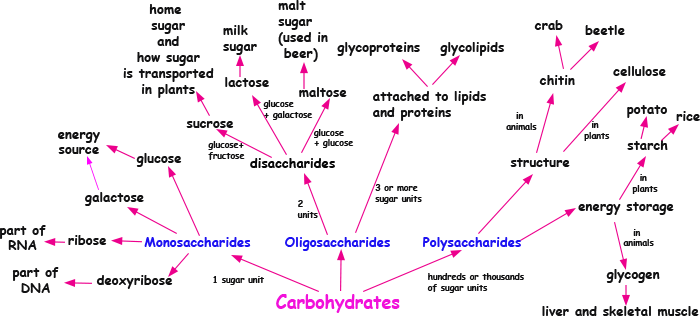Carbohydrates (sugar)
CONCEPT MAP

This map summarizes various ideas.
Carbohydrates , as the name implies, consists of carbon and water (hydro), so that their empirical formulae are Ch20. They are essential for life, either as monomers or as polymers.
Just revising , a polymer is a very large molecule, made of lots of monomers joined together. Monomers of carbohydrates are part of DNA and RNA molecules. As food, carbohydrates normally appear in pairs (disaccharides), like sucrose or lactose. Slightly larger structures of carbohydrate monomers joined together (oligosaccharides) are found on the outer side of the cell membrane, joined to proteins (glycoproteins) or to lipids (glycolipids). A cell membrane is full of these structures pointing out from its surface , to the point that it looks like the roof of an old building covered with aerials of all sizes and shapes. They have the important role of recognizing molecules that approach and to decide if they are allowed to enter the cell or not. Viruses, for example, have glycoproteins on their surfaces to interact with the glycoproteins on the external surface of the cell to try to gain access. Once inside the cell, they start to multiply and cause destruction.
Polymers of carbohydrates (polysaccharides ) like glucose, for instance, are the building materials of plants (cellulose) and they also make the exoskeleton of certain animals (chitin), like crabs and insects. In addition to being structural polymers, polysaccharides are also used for energy storage, in the form of glycogen (in animals and fungi) or starch (in plants). Glycogen is stored mainly in muscle (that is why we see a quick increase in muscle mass after a short exercise) and in the liver (as storage for the whole body, especially the central nervous system).
What is the point of storing glucose as glycogen and not as the monomer? The answer is related to the concept of osmosis, which is very important in biochemistry. The cell membrane is semi-permeable so that water can move across by osmosis. The interior of the cell is a gel-like material containing numerous substances, like proteins and minerals. If a lot of carbohydrates are stored inside the cell in the form of mono or disaccharides, water will be strongly pulled to the inside (osmotic pressure). That could cause the rupture of the cell . By converting the glucose monomers into glycogen, there is no build up of osmotic pressure.
Bacteria are killed by penicillin because it weakens the cell walls and the bacteria burst because of the osmotic pressure pulling water to the inside!
© Ricardo Esplugas - ricardochemistry@gmail.com

-Image-250.gif)
